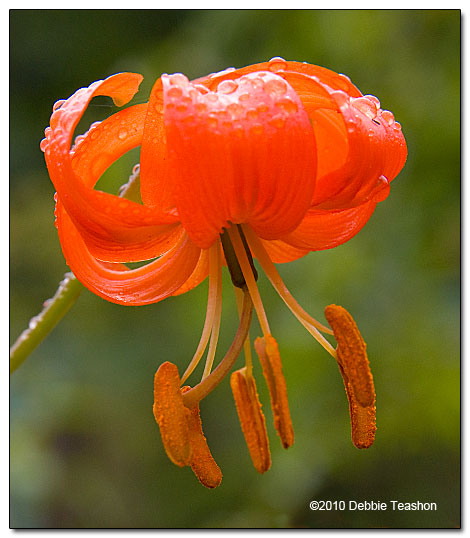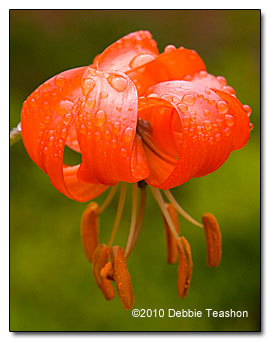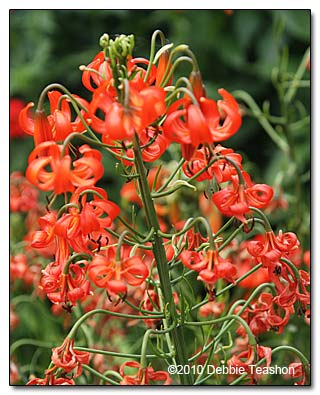Lilium pumilum
CORAL LILY, SIBERIAN LILY, TURK'S CAP LILY
syn. L. tenuifolium
Family: Liliaceae
Pronounced: LIL-ee-um PEW-mil-um
Quick Jumps
Growing Guide
Rainy Side Notes
GROWING GUIDE

Origin:
North China, North and South Korea, Siberia and Mongolia.
Plant Group:
Bulbs.
Hardiness:
Sunset zones: 1-10, 14-24.
USDA zones: 3-7.
Heat zones: 8-5.
Mature size:
Height: 18 inches (45 cm).
Flowering period:
Late spring to early summer.
Flowering attributes:
Fragrant, nodding, orange-red, recurved petals, with up to 30 Turk's cap flowers per stem.
Leaf attributes:
Linear, grass-like, 4-inch long leaves grow in whorls along slender stems.
Light:
Full sun to partial shade.
Soil:
Sandy to loamy, well-drained soil.
Propagation Methods:
Sow fresh seed and place in cold frame over winter.
In spring, sow seed at 70-75°F (21-23°C). Follow by placing in refrigerator for 3 months or later in a cold frame over winter.
Dig up and then plant bulblets, scales and offsets after foliage dies down.
Rainy Side Notes


You can't help but be cheerful when you see a mass planting of Lilium pumilum, its bright, coral-red flowers illuminating the landscape. This is a choice lily for the cutting garden. It lasts long as a cut flower, and not only that, one stem gives you an instant bouquet. The bulbs thrive in any well-drained soil and are equally at home in the rock garden. This species is stunning in the landscape; as well as an exciting edition to summer containers.
You can easily propagate these bulbs by digging up the bulblets when foliage has ripened. The plants are short-lived, but you can prolong their lives by not letting them go to seed. Alternatively, collect the seed and start new ones every few years. When grown from seed, the plants will be dangling their blossoms by the second year. Regardless of how many varieties of lilies you may grow nearby, this plant will have its own genetic makeup. Since the species was introduced in 1816, its pollen has been used in many crosses, such as 'Goldcrest', 'Golden Chalice', and 'Scamp' and other remarkable hybrid strains.
With a plant this beautiful, you wouldn't expect it to be medicinal. It is used in traditional Mongolian medicine to treat liver and gastrointestinal disorders. Recent scientific studies concluded that extracts from the plant stimulate bile flow and has the added benefit of no toxicity to the liver.
With a short stature, it's no surprise that its epithet pumilum means dwarf. Even the bulbs are dwarf little things about the size of marbles.
One of its common names, Turk's cap lily, is used for other lily species such as Lilium martagon and L. superbum. Both species have the same downward facing flowers with reflexed petals. If you want to grow L. pumilum, make sure the tag has its botanical name or you may end up with another species.
Top two photographs taken in author's garden. Bottom image photographed at Joy Creek Nursery, Scappoose, Oregon.

Gardening for the Homebrewer: Grow and Process Plants for Making Beer, Wine, Gruit, Cider, Perry, and More
By co-authors Debbie Teashon (Rainy Side Gardeners) and Wendy Tweton
Copyright Notice | Home | Search | Bulbs

